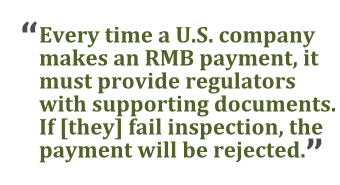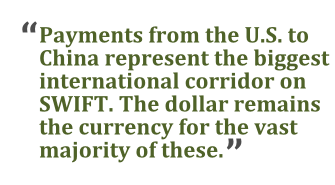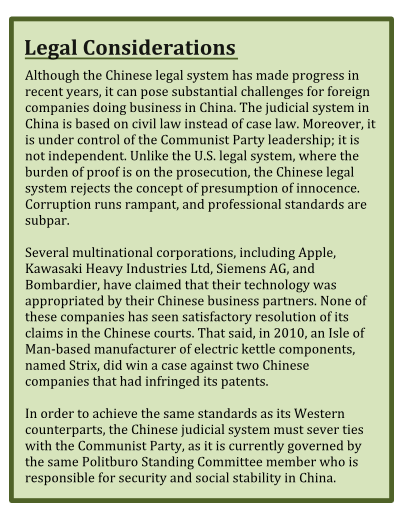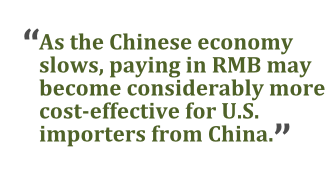Despite the spectacular economic development China has engineered, the use of the renminbi (RMB) has not grown at the same pace as the country's industries. Many U.S. businesses that source from China continue to pay their suppliers in U.S. dollars. Doing so is convenient, and it eliminates foreign exchange (FX) risk in those transactions. It also costs more, and it puts these companies at a disadvantage compared with businesses that are willing to transact in RMB.
As China has liberalized the RMB over the past decade, an increasing number of European, Australian, and Asian companies have begun making RMB-denominated deals. If China continues to experience a credit squeeze and deceleration in economic growth, U.S. companies may find themselves under increasing pressure to use the local currency when working with Chinese trading partners. The time is right to evaluate the pros and cons of paying and billing in RMB.
History of RMB Transactions
For more than a decade, the value of the RMB was pegged to the U.S. dollar. In 2005, the People's Bank of China (PBOC) permitted the RMB to begin moving but limited its swings in value to a maximum of 0.3 percent per day when compared with a basket of other currencies. In 2012, the PBOC increased the RMB's trading band against the basket of currencies to 1 percent per day. Today, the value of the RMB is 25 percent higher than it was in July 2005.
At the same time it began loosening the reins on the RMB's value, the PBOC began working directly with foreign governments to encourage use of its currency. Emerging from the global financial crisis of 2008, Chinese President Hu Jintao called for “a fair, just, inclusive, and well-managed international financial order.” The PBOC began signing bilateral swap agreements (BSAs) with the central banks of other countries. Through these deals, the nations exchange a specified quantity of RMB for the other country's currency, at a specified exchange rate. This enables the other central bank to lend in RMB to institutions in its jurisdiction, and it enables Beijing to encourage use of its currency abroad while maintaining quite a bit of control over foreigners' use of RMB.
Usually this type of central bank currency swap is designed to improve a nation's liquidity in the event of, or in order to prevent, a financial crisis. But according to the PBOC, the main purpose of the Chinese BSAs is to promote the use of the RMB in global trade and investment. To date, Beijing has signed BSAs with more than 20 central banks, accounting for a total of more than $1 trillion yuan.
The PBOC also launched bilateral RMB clearing systems with the central banks of Hong Kong, Macao, Taiwan, Singapore, and the United Kingdom in an effort to further facilitate cross-border RMB settlements. Going forward, it will be interesting to see whether capital controls between China and Singapore ease further if Singapore develops as a source of offshore RMB liquidity.
Current State of the Currency
As the Chinese government has relaxed controls on the RMB, it has reduced the barriers to RMB-denominated deals. U.S. companies are now able to purchase RMB directly from large global banks or through independent foreign exchange providers. The only limitation that the Chinese government currently places on the size of RMB settlements involves individual Chinese citizens, who can exchange a maximum of US$50,000 per year worth of RMB for use in overseas purchases or investments. Because there is no limit on the volume of U.S. dollars (USD) that a Chinese citizen can move into RMB, foreign companies with operations in China may want to make payments to individuals, such as salaries, in USD so that those individuals have optimal flexibility in how they spend the money. The PBOC has announced that it may lift even this restriction by the end of this year.
Nevertheless, making a cross-border payment denominated in RMB is not as simple as making a cross-border payment in USD. First, a distinction should be made between the RMB used in transactions within the borders of mainland China (CNY) and RMB traded offshore, mainly in Hong Kong (CNH). The CNY is the currency that still fluctuates within a tight trading band controlled by the PBOC (1 percent maximum shift per day relative to a basket of other currencies). The CNH, which enters FX markets via the PBOC's bilateral swap agreements, moves freely with the market. But because the PBOC tightly controls the supply of CNH, demand usually exceeds supply, and the CNH usually trades above the value of the CNY. Chinese companies usually convert their CNY into foreign currencies in Hong Kong at the more attractive CNH rate.
Payments in mainland China that are denominated in RMB are processed through the China National Advanced Payment System (CNAPS). Clearing interbank payments through the system often involves manual data entry, which raises the unit cost of each transaction. In addition, the CNAPS clearing code is more complex than SWIFT Bank Identifier Codes (BIC), which can pose a roadblock to identifying the beneficiary bank in a payment and slow down delivery of payment. To improve the efficiency of RMB-denominated trade, Beijing needs to streamline its clearing processes so that payments in RMB are not further delayed.
More cumbersome, every time a U.S. company makes an RMB payment, it must provide Chinese regulators with supporting documents, including the invoice, contract, and customs declaration form. And although regulators are also receiving this documentation, the banks that are party to a transaction must investigate the background of the transaction to ensure that it complies with Chinese policy. If the supporting documents fail inspection, the payment will be rejected, which may delay the processing of the transaction by a week or more.
Global Growth for the RMB
China's efforts to boost global use of the RMB have been somewhat successful. According to SWIFT, the value of RMB-denominated payments expanded 171 percent between January 2012 and January 2013. In fact, in the three months from December 2012 to March 2013, RMB payments rose in value by 32.7 percent, whereas the value of payments in other currencies rose an average of 5.1 percent. Globally, 29 percent of the 160 nations that exchanged payments with China and Hong Kong in April 2013 denominated at least 10 percent of those transactions in RMB. That's an increase of 10 percentage points (almost 50 percent) since July 2012.
While still falling behind in global transactions, the RMB increased its market share this June to 0.87 percent. The RMB is now one position away from being in the world's top 10 currencies in terms of total value of payments, having overtaken the Thai baht and Norwegian krone.
Regionally, as China has begun to loosen its grip on its currency, East Asia has developed into an RMB bloc. China increased liquidity in the region by appointing the Industrial and Commercial Bank of China as an official RMB clearing bank in Singapore and debuting “dim sum” bonds (CNH-denominated bonds) in Singapore. Now seven of the 10 countries in the region—including South Korea, Indonesia, Taiwan, Malaysia, Singapore, and Thailand—track the RMB to a greater degree than the U.S. dollar.
Among European countries, France is in the pole position for transacting in RMB, recording a 249 percent increase in the total value of payments since March 2012. Today, 21.4 percent of payments made between France and China/Hong Kong are denominated in RMB, compared with 6.5 percent of payments only a year ago. France ranks third in the world in terms of the value of offshore RMB payments, behind the United Kingdom and Singapore.
The rapid acceleration in the value of French RMB transactions exposes increased competition between France and the U.K. In June 2013, the Bank of England finalized a three-year bilateral swap agreement with China. Fast on the heels of France and the U.K. are Italy, Luxembourg, and Russia, which are currently among the strongest adopters of the RMB.
U.S. Companies Aren't Keeping Up
In this rush toward the RMB, U.S.-based companies are lagging. The United States is in sixth place—behind the U.K., Singapore, Australia, France, and Luxembourg—in terms of the total value of RMB-denominated offshore payments. U.S. trade with China increased more than three-and-a-half times faster than total U.S. foreign trade in the last decade, and payments from the U.S. to China represent the biggest international corridor on SWIFT. Nevertheless, the U.S. dollar remains the settlement currency for the vast majority of these transactions.
The principal reason why U.S. companies have been slow to adopt the RMB is that they're hesitant to accept the FX risk. Obviously, paying in U.S. dollars eliminates foreign exchange risk for companies that do most of their business in USD.
But for companies that both buy and sell goods or services in China, denominating both payables and receivables in RMB is a smart way to create a natural hedge. Foreign exchange risk is eliminated and margins preserved, as exposures can be netted. U.S. businesses that take this approach are rarely interested in converting RMB profits into U.S. dollars for use in North American operations. The U.S. tax code discourages profit repatriation, and some analysts believe the RMB is undervalued by as much as 40 percent relative to the USD.
Another option for U.S. companies is to apply for Wholly Foreign Owned Enterprise (WFOE) incorporation in China. Doing so enables the organization to denominate transactions in RMB, then repatriate profits into U.S. dollars to send back to the parent company in the United States. WFOE status would enable the business to maximize profits in mainland China and prevent potential leakage of its intellectual property, and attaining this status does not require the cooperations of an investor from mainland China.
Companies that primarily buy from or sell to China, but don't do both, also have options. As Beijing has moved away from the fixed exchange rate with U.S. dollars, toward full internationalization of the RMB, it has created new opportunities for foreign entities to hedge their exposure to the currency. U.S. firms now have the flexibility to use deliverable forward contracts, as well as non-deliverable forwards, to mitigate their RMB FX risk. They are no longer restricted to transacting solely on the spot market, which subjects them to market volatility. This greatly improves the competitive position and cash flow of U.S. companies that do business in China, while it reduces the overall cost of hedging.

Benefits of RMB Transactions
As they become more comfortable with their ability to mitigate FX risk, U.S. companies should consider paying Chinese suppliers in RMB. One significant reason is that the PBOC estimates transacting in U.S. dollars increases the cost of a transaction in China by 2 to 3 percent, which equates to US$10,000 to US$15,000 on a US$500,000 invoice. Other estimates peg the premium for trading in USD as high as 5 percent. Chinese companies factor RMB appreciation into their price to hedge against the possibility that the exchange rate will move unfavorably before the trade is settled. This buffer means that U.S. companies are paying a premium for transacting in USD.
Another consideration is that foreign companies which won't consider denominating transactions in RMB may be putting themselves at a disadvantage compared with their competitors. A growing layer of smaller Chinese businesses are opening their doors to outside markets. Many of these companies prefer to use their own currency, and some are reluctant to take on dollar exposure because their cost base is denominated in RMB. U.S. organizations that are willing to trade in RMB broaden their network of prospective buyers and suppliers.
Finally, making payments in RMB has the potential to speed up the supply chain. A Chinese supplier might be able to accelerate product delivery if it no longer needs to spend time converting USD to RMB to fund its local operations. Consider, for example, what might happen to a company's supply chain around the Chinese New Year. The nation essentially shuts down to celebrate the holiday, with factories closing one to two weeks prior to the Lunar New Year and remaining closed until two weeks after the date. Regardless of how this holiday fits into Western companies' demands, freight in China will be at a standstill. If the Chinese supplier has to convert USD to RMB, in addition to manufacturing and shipping the goods, the Lunar New Year may defer delivery even more than it otherwise would. Since banks and independent FX providers now offer RMB conversion, U.S. companies that are willing to use RMB for procurement can reduce that added friction in the production cycle.
A Well-Charted Course
The RMB will undoubtedly continue to experience foundational change. The PBOC will probably allow the onshore RMB to move to a free-floating model; the Chinese central bank predicts that the RMB will achieve full convertibility by 2015. However, achieving this goal will require Beijing to relax its capital account regime and domestic financial controls, which will impact its state-owned banking system and its practice of offering privileged lending to state enterprises. Internationalization will cause a good deal of turbulence for the Chinese economy and political regime.
Over the past few centuries, the world's principal reserve currencies have been issued by democracies. Britain and the United States hold contested elections and have political systems that limit the arbitrary exercise of executive power. Such institutions are missing from China's political system. Modern China maintains a tight grip on its people, who are increasingly expressing dissent through demonstrations.
The slowing Chinese economy and volatility in Chinese financial markets have added to this turmoil. In mid-August, the China Banking Regulatory Commission reported that bad loans at Chinese banks have grown for seven quarters in a row, across all categories of financial institutions. At the same time, Chinese GDP growth slowed for the second straight quarter, as factory output and fixed asset investment decelerated. And because many analysts have accused Beijing of manipulating its economic data, the actual degree to which Chinese markets are struggling remains unclear.
Regardless, GDP growth is clearly slowing, and the credit environment in China is tightening. As the Chinese economy slows and momentum gathers around idea that the PBOC should depreciate the yuan to support the export sector, paying in RMB may become considerably more cost-effective for U.S. importers from China. Year to date, the RMB has appreciated 5 percent compared with a basket of currencies. (That appreciation may well be one of the reasons China has lost some of its competitive edge.)
Many companies that do business in China will find that the optimal solution is to denominate some transactions in U.S. dollars and others in renminbi. A prudent approach for U.S. companies sourcing from Chinese suppliers is to request that invoices be quoted in both USD and RMB. This enables the buyer to evaluate which currency would be more beneficial to settle in. It also improves transparency and may strengthen the business relationship. As the RMB's role on the world stage continues to evolve, multinational businesses are wise to find a bank or independent FX provider that can deliver RMB payments in mainland China. By doing so, they will prepare themselves for trade in a currency that may not only deliver cost savings, but also enhance their competitiveness and ability to profitably do business in China.
———————————
 Anil Sawrup is senior vice president of payment and risk solutions for Cambridge Mercantile Group in Toronto. He has more than 20 years' experience working with large companies to implement FX and payments strategies.
Anil Sawrup is senior vice president of payment and risk solutions for Cambridge Mercantile Group in Toronto. He has more than 20 years' experience working with large companies to implement FX and payments strategies.

Cheryl Girling is national account manager for Cambridge Mercantile Group in Montreal, where she helps lead a team of risk management specialists in orchestrating complex FX programs for midsize to large organizations.
© Touchpoint Markets, All Rights Reserved. Request academic re-use from www.copyright.com. All other uses, submit a request to [email protected]. For more inforrmation visit Asset & Logo Licensing.



